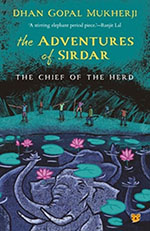The Adventures of Sirdar is an interesting story about the life of a herd of wild elephants. It begins with the dramatic selection of ‘Sirdar’, a thirty year-old male elephant as the youngest leader of the herd and his life from then on. The author, Dhan Gopal Mukherji, describes how Sirdar leads his herd.
Mukherji wrote children’s books in the 1920s in America and was the first Indian writer to win the prestigious Newbery Medal in 1928 for Gay-Neck: The Story of a Pigeon. Mukherji predominantly wrote about India, animals and things Indian–his stories gave the world an interesting window into a land largely unknown at the time.
Our story is told from Sirdar’s perspective by a narrator and the hathi speaking in the first person. Mukherji gives the animal protagonists in his books a voice, to ‘speak’ directly to the reader. To quote, ‘It is not hard for us to understand him,’ the first-person narrator says, in Gay-Neck: The Story of a Pigeon of the anthropomorphic bird, ‘if we use the grammar of fancy and the dictionary of the imagination’. This can be applied to Mukherji’s other protagonists from the animal kingdom.
The author describes how the herd goes about its business of living in the jungle, its composition, how they choose their leader, gather their food, find water and shelter, encounter danger, stay safe, mate, the birth of young ones and where they go in the deepest jungle when they sense the end is approaching…the entire life cycle of the pachyderms. He does so with sensitivity and insight from the point of view of Sirdar. Mukherji ascribes human emotions to his animal protagonists in many of his stories. The stars of this book, the elephants, feel parental love, loyalty, fear, anger and grief, emotions that motivate everything they do. Just as Mukherji ascribes human emotions to his ‘animal’ characters, he also fashions the elephant families and the herd, on the hierarchy and patriarchal structure of human families of his time. An elephant herd is led by a matriarch–the oldest female elephant as shown by scientific studies now. And it is the mothers who nurture and raise the elephant calves. Father elephants are not involved in this activity as our Sirdar was shown to be. The publisher’s note at the end of the book is very useful and important to correct the infomation for impressionable young minds reading the book and taking the story to be the basis of their knowledge! However, the author’s imagination gives us a lovable hero and his adventures.
The charming cover illustration by Jayesh Sivan picturizes the highpoint from the chapter ‘The Art of Leadership’, and how Sirdar helped his herd escape a band of gun-bearing men who wanted to trap them. Sirdar instructed his herd to run to the lotus lake and to do as he did. To escape the hunters and their bullets, he submerges himself in the lotus lake with only the tip of his trunk sticking out just above the suface of the water, concealed by a lotus leaf. Hathi after hathi quietly follow their leader’s example and escape being shot for ivory or captured for labour.
The cover endorsements by Ranjit Lal and Bijal Vachharajani are teasers for what you can expect in the story! The author’s lyrical style and descriptions of the setting and the social milieu of the period–the laws for the protection of wild elephants and those allowing shooting of rogue ones in pre-Independent India, the kheddah operations and the man-animal interactions, the crop raiding activities of errant members of Sirdar’s herd.
Mukherji’s keen observation of nature and expession of the same in lyrical prose will make his readers linger on a page, read again and vividly picture the story and setting in their mind’s eye. For example: ‘The twilight passed. The solemn moment of silence that separates day from the dark throbbed on the drum-like surface of the lake then sang into the stillness of the night. Tigers roared far off, owls hooted, bats fanned the air above our heads as we swam across the lake behind the ambush of dusk.’
I was amused by the passage quoted below; how effortlessly Mukherji transports a bulky elephant herd in time and space, while describing what they ate! ‘After the mating season was over the herd moved in many directions. They ate the June foliage of Bramhaputra plateaus and the July grass of the Tista. August found them moving slowly towards the Gangetic Valley of the south.’ The Adventures of Sirdar was originally published as The Chief of the Herd in 1927. This kid-lit gem, retitled and published in this new edition by the Talking Cub imprint of Speaking Tiger Books will enchant children and also their parents, who may have missed the sublime writing of Dhan Gopal Mukherji.
November 2023, volume 47, No 11

